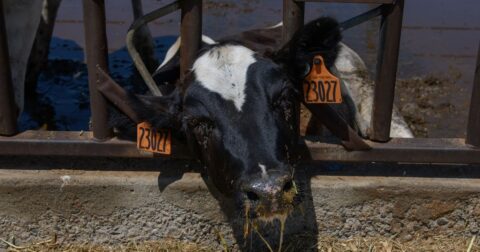Explainer
Agriculture Affects Deforestation Much More Than Most People Realize
Climate•7 min read
Feature
Nearly all farm animals in the U.S. are confined in industrial operations that lack adequate space, ventilation or cooling systems.


Words by Gaea Cabico
As a record-breaking “heat dome” blanketed the United States in late June, just a few days after summer officially started, millions of Americans were urged to stay cool, hydrated and indoors. But while public health warnings and cooling systems help people avoid the worst of extreme heat, animals crammed in factory farms or packed into trucks during transport have no way to escape the soaring temperatures.
There is no official data on how many farm animals were affected by the recent U.S. heatwave, but “we don’t need reports to know that they are suffering,” Matthew Dominguez, U.S. director of the animal welfare organization Compassion in World Farming (CIWF), tells Sentient. States with the highest concentrations of farm animals — such as those in the Midwest and the South — are also among the most vulnerable to extreme heat, Dominguez notes.
“They tend to be the states that have state legislatures that don’t do anything to protect farm animals,” he says. “These factory farms have no measures in place to prevent abuses happening to these farm animals, let alone protect them from extreme heat that we’re facing, particularly this summer.”
Livestock production — particularly beef — is a major contributor to the warming of the planet, accounting for 12 percent of all greenhouse gas emissions, according to the Food and Agriculture Organization. Other studies point to higher numbers, as much as 19.6 percent of all global emissions.
At the same time, animals raised in factory farms are among the most vulnerable to the impacts of the climate crisis. As Dominguez says, “we’re leaving them to die or suffer in these extreme weather conditions that are, in fact, caused by the very industry” that confines them.
Heat stress occurs when animals take in or generate more heat than they can release. The impact is even “more pronounced” when high temperatures are combined with humidity, making it harder for animals to cool down through sweating or breathing, says Imen Belhadj Slimen, a professor at the National Agricultural Institute of Tunisia who studies the effects of heat on livestock.
This strain disrupts the animals’ metabolism and immune function, shifting their energy from growth and reproduction to basic survival. As a result, they become more susceptible to illness. Extreme heat can lead to unconsciousness or death in severe cases. In June 2017, an estimated 4,000 to 6,000 cows died during a heat wave in California. More recently, in July 2023, around 370 cattle died in Iowa due to extreme heat and humidity.
Farmers also have incentive to improve the welfare of their animals. Studies have also linked extreme heat to declines in egg production and milk production, as well as reduced meat quality.
According to the latest data from the U.S. Department of Agriculture, 31 percent of the nation’s sheep, 21 percent of dairy cows, 18 percent of cattle and six percent of hogs are located in areas currently experiencing drought. Climate change also makes droughts longer, more frequent and more severe. The unusually dry weather is also affecting alfalfa, a water-thirsty crop fed to cattle, sheep and goats. Currently, 32 percent of the hay acreage in the U.S. is located in areas affected by drought.
In the U.S., 99 percent of farm animals are raised on factory farms, where they are confined in cramped spaces with little to no ventilation or cooling systems. “Even in normal circumstances, animals die in very difficult conditions. But the heat just adds an additional stressor to an already very uncomfortable and inappropriate housing situation,” Gene Baur, president and co-founder of Farm Sanctuary, tells Sentient.
High temperatures can also severely compromise animal welfare during transport, which is already stressful due to overcrowded conditions and long journey times. In the summer of 2022, as temperatures in the United Kingdom soared to 40°Celsius (104°Fahrenheit), nearly 10,000 chickens died from heat stress on their way to a slaughterhouse.
Standard cooling systems “are not enough to provide animal welfare” during extreme heat, Slimen tells Sentient. She says that misting, which cools the air by turning water into vapor, becomes less effective during heat waves because the air is already too humid for the water to evaporate properly.
Fans and vents, which usually work by bringing in cooler outside air, also fall short when the outside temperature is too hot. “Ventilation just circulates this hot air, which does not help animals to cool down,” Slimen says.
Dominguez adds that many industrial animal facilities lack basic fire protections like sprinklers, and the industry has continued to resist reforms that could reduce the risk of barn fires.
Why don’t farmers and businesses take steps to protect animals on their own? Because it’s often more profitable not to, Andrew deCoriolis, executive director of Farm Forward, tells Sentient.
“It’s more profitable to let animals die or be sickened or to have decreased production than it is to raise them in conditions that might actually ameliorate conditions of extreme heat,” he says.
DeCoriolis, Dominguez and Baur are critics of government programs that reimburse farmers for animal deaths without requiring any improvements in animal welfare. The USDA’s Livestock Indemnity Program, for example, covers 75 percent of the average market value of animals that die in unusually high numbers due to extreme weather events such as hurricanes, floods, wildfires and extreme heat.
Similarly, the Emergency Assistance for Livestock, Honey Bees and Farm-Raised Fish Program provides financial assistance to producers who have lost flocks due to diseases like bird flu, or from severe weather. The USDA’s own research suggested that bailouts to poultry producers without any incentives resulted in farmers taking no added precautions to protect their flocks.
“Government programs should not be used to bail out and help industry profit when they engage in irresponsible practices,” argues Baur.
When industrial farms ask for government money after extreme weather events, there should be conditions, argues DeCoriolis. Some potential “strings” might be “having to implement new technologies, new handling practices, new potentially breeding practices so you’re less likely to need that same money next summer when you have the same extreme heat event.”
He adds that any future payments should depend on whether the farm has put better practices and technologies in place.
To help animals cope with extreme heat, farms need to improve their cooling systems, says Slimen. This includes installing ventilation with automatic controls, cross or tunnel airflow, and advanced options like evaporative or geothermal cooling and having backup generators to avoid ventilation failures during power outages. However, air conditioning is often too expensive and not practical for large-scale industrial operations.
Beyond technology, Slimen emphasizes the need to change how animals are raised in the first place. Reducing farm animal density on farms can lower heat stress. Nutrition also plays an important role: Poultry need more energy-dense diets during hot weather, while ruminants like cows benefit from additional fat and protein sources.
Trees or artificial barriers like shade cloth and galvanized metal sheets are low-cost ways to lower surface temperatures and reduce heat reflected onto animals.
At Farm Sanctuary’s animal shelters — which are obviously entirely different from factory farms — “we’re doing the best we can to adapt to the changing and extreme climate swings that we’re seeing,” says Baur. Around 500 rescued cows, pigs and turkeys from industrial farms now roam the green pastures of the sanctuary’s 275-acre location in upstate New York and at a 39-acre hacienda-style ranch in Los Angeles, California. Farm Sanctuary’s first rescued animal — a sheep named “Hilda” — was found discarded atop a pile of dead animals in Lancaster, Pennsylvania after collapsing from heat exhaustion.
Baur says they use fans in the barns and give animals access to outdoor areas with shade from trees. “We are also trying to manage the land in a sustainable, eco-friendly way and create a more resilient habitat, more generally, for our domesticated animals but also just let nature kind of moderate.”
“The bare minimum that we can all agree on is that they shouldn’t be locked in barns where they’re essentially being cooked in an oven to death,” says Dominguez, about industrial farm living conditions for most animals.
Beyond improving farm conditions, advocates interviewed by Sentient emphasize the importance of shifting towards plant-forward diets to reduce the demand for meat that drives overcrowding on factory farms in the first place. That shift, however, faces a major hurdle: Americans consume an average of 224.9 pounds of red meat and poultry per person each year, according to 2022 data from the U.S. Department of Agriculture.
So how can that transition happen? It could take many-forms, says deCoriolis. It might start with schools, hospitals, universities and businesses offering more plant-based options to encourage people to choose them. At the same time, the animal agriculture industry should be more strictly regulated not just in terms of animal welfare, but also its environmental impact, he argues.
“As we regulate the animal agriculture industry appropriately, the industrial animal agriculture industry responds by having to make the kinds of changes that would improve the lives of animals,” he says. Requiring the industry to take steps to protect air and water too might translate to higher priced meat at the grocery store, he says, which could mean “people will eat less of it.”